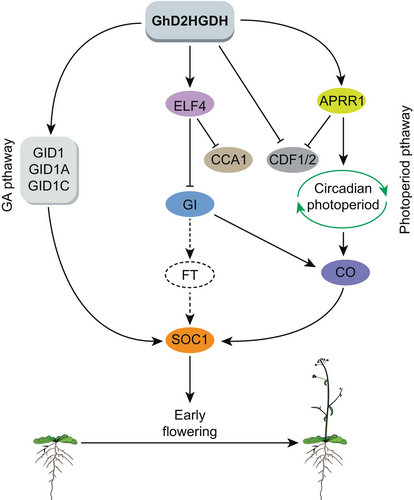- Location : Home» Newsroom
A cotton mitochondrial alternative electron transporter, GhD2HGDH, induces early flowering by modulating GA and photoperiodic pathways
D-2-hydroxyglutarate dehydrogenase (D2HGDH) is a mitochondrial enzyme containing flavin adenine dinucleotide FAD, existing as a dimer, and it facilitates the specific oxidation of D-2HG to 2-oxoglutarate (2-OG), which is a key intermediate in the tricarboxylic acid (TCA) cycle. A Genome-wide expression analysis (GWEA) has indicated an association between GhD2HGDH and flowering time. To further explore the role of GhD2HGDH, we performed a comprehensive investigation encompassing phenotyping, physiology, metabolomics, and transcriptomics in Arabidopsis thaliana plants overexpressing GhD2HGDH. Transcriptomic and qRT-PCR data exhibited heightened expression of GhD2HGDH in upland cotton flowers. Additionally, early-maturing cotton exhibited higher expression of GhD2HGDH across all tissues than delayed-maturing cotton. Subcellular localization confirmed its presence in the mitochondria. Overexpression of GhD2HGDH in Arabidopsis resulted in early flowering. Using virus-induced gene silencing (VIGS), we investigated the impact of GhD2HGDH on flowering in both early- and delayed-maturing cotton plants. Manipulation of GhD2HGDH expression levels led to changes in photosynthetic pigment and gas exchange attributes. GhD2HGDH responded to gibberellin (GA3) hormone treatment, influencing the expression of GA biosynthesis genes and repressing DELLA genes. Protein interaction studies, including yeast two-hybrid, luciferase complementation (LUC), and GST pull-down assays, confirmed the interaction between GhD2HGDH and GhSOX (Sulfite oxidase). The metabolomics analysis demonstrated GhD2HGDH's modulation of the TCA cycle through alterations in various metabolite levels. Transcriptome data revealed that GhD2HGDH overexpression triggers early flowering by modulating the GA3 and photoperiodic pathways of the flowering core factor genes. Taken together, GhD2HGDH positively regulates the network of genes associated with early flowering pathways.
This work was supported by funding from the National Key Research and Development Program of China (2023YFD2301201), Natural Science Foundation of Henan (232300421010), National Natural Science Foundation of China (No. 32350410409) and the Key Research and Development Project of Henan Province (231111110400).
